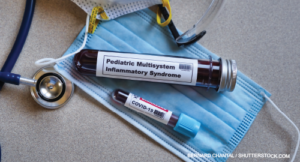 During the peak of the coronavirus pandemic in Washington, D.C., we were asked to evaluate a 14-year-old boy admitted to the pediatric hospitalist service. He had been healthy until two weeks before, when he noted a sore throat, and soon after he developed fevers and rashes without congestion, shortness of breath, conjunctivitis or swollen lymph nodes.
During the peak of the coronavirus pandemic in Washington, D.C., we were asked to evaluate a 14-year-old boy admitted to the pediatric hospitalist service. He had been healthy until two weeks before, when he noted a sore throat, and soon after he developed fevers and rashes without congestion, shortness of breath, conjunctivitis or swollen lymph nodes.
He was evaluated by his pediatrician, and the initial evaluation revealed abnormal inflammatory markers, including leukocytosis, elevated erythrocyte sedimentation rate (ESR) and C-reactive protein (CRP), a normal platelet count and normocytic anemia. Ferritin was markedly elevated at 5,200, and D-dimer exceeded the upper limits of the test. N-terminal-pro hormone B-type natriuretic peptide (NT-proBNP) and troponin tests were negative. SARS-CoV-2 IgG and polymerase chain reaction (PCR) tests were negative, although at the time of presentation, community spread of COVID-19 was high.
Later, in the emergency department, he was febrile and tachycardic, but did not appear acutely ill. Given the possibility of multisystem inflammatory disease in children (MIS-C), he was admitted for further observation.
Although the patient’s overall clinical impression was reassuring, the prolonged fevers, evidence of multisystem involvement with rashes, hematologic findings and elevated inflammatory markers were suggestive of MIS-C. However, findings that weren’t consistent with MIS-C, such as the duration of fever, uncertainty about the patient’s SARS-CoV-2 exposure, the highly elevated ferritin, as well as the initial complaint of cough two weeks prior to his hospitalization, all raised the possibility of an alternative diagnosis.
As pediatric rheumatologists practicing during the COVID-19 pandemic, we all have likely faced similar cases in which patients appear to fit the case definition of MIS-C, but the symptoms and lab findings are not clear-cut.
The Global Burden of MIS-C
MIS-C, a hyperinflammatory condition recognized initially in the U.K., is broadly characterized by fever, multi-organ dysfunction, elevated inflammatory markers, evidence of recent SARS-CoV-2 infection and reasonable exclusion of alternative diagnoses (see Table 1).1
Although causal evidence is lacking, it is widely presumed that MIS-C-associated inflammation is likely a late manifestation of prior SARS-CoV-2 infection that is clearly distinct from primary SARS-CoV-2 infection. Although a relatively low incidence of MIS-C in the U.S. of ~316 cases per 1 million infections is reported, up to 80% of patients may require intensive care unit (ICU) level care due to cardiac abnormalities, and 2% may die.2,3
With the recent emergence of MIS-C and its recognition as a clinical entity, our understanding of the condition is still in its infancy. Physicians have relied on case definitions set forth by the Centers for Disease Control and Prevention (CDC) and the World Health Organization (WHO).4
The uncertainties about what MIS-C is and the pathophysiology that initiates and perpetuates the uncontrolled inflammation have provided a diagnostic and therapeutic challenge to practicing pediatric rheumatologists.
Further, even though the current case definitions set forth by the CDC and WHO are deliberately broad so that MIS-C is not missed, the clinical expertise of frontline providers is needed to interpret the available information to make the correct diagnosis. Based on new information we have learned since MIS-C was officially recognized, can we refine our clinical and diagnostic framework of MIS-C to identify patients sooner and more definitively?
Refining the Clinical Entity of MIS-C
Using the CDC case definition as a guide, we can build on our current framework for MIS-C with established observations published since the condition’s emergence in 2019.
1 – Patients younger than 21 years old with fever greater than 38°C for more than 24 hours
In contrast to patients with Kawasaki disease, who are typically under 5 years old, children diagnosed with MIS-C are older, typically 4–13 years old; however, one-third of patients diagnosed with MIS-C are 5 years old or under.5 When compared with benign pediatric febrile illnesses in outpatient settings, patients with MIS-C typically have higher documented fevers, around 40°C, averaging five days in duration before medical attention is sought.6
Our patient’s age was not classic for Kawasaki disease, and his duration of fever was considerably longer than what is observed for a benign febrile illness, suggesting a concerning inflammatory condition, such as MIS-C.
2 – Evidence of multisystem involvement
It is now appreciated that MIS-C is a clinically heterogeneous inflammatory disease that includes at least three phenotypic subtypes: 1) cardiovascular (CV) or toxic shock-predominant disease; 2) Kawasaki disease-like features; and 3) non-specific inflammatory symptoms without overt shock or Kawasaki disease-like features.1,7
With the recent emergence of MIS-C & its recognition as a clinical entity, our understanding of this condition is still in its infancy.
Given these diverse presentations, MIS-C can also be described as a spectrum of disease severity, with CV shock representing severe illness due to the high likelihood of requiring ICU level of care, and Kawasaki disease-like and non-specific inflammation as moderate and mild illness, respectively.8
Certain organ systems are more likely to be affected in MIS-C than others. For example, cardiac, gastrointestinal, hematologic, mucocutaneous, respiratory and musculoskeletal involvement are frequent in more than half of MIS-C patients, and renal or neurologic involvement is less uncommon.9,10
The majority of patients present with at least three organ systems involved, and roughly one-third of patients present with clinical features and laboratory findings consistent with Kawasaki disease.9 Non-specific symptoms, including myalgias, nausea/vomiting and cough, are common in MIS-C. Not surprisingly, the presence of clinical symptoms of Kawasaki disease, such as conjunctivitis, extremity changes, rashes and mucocutaneous lesions, help differentiate MIS-C from other benign febrile illnesses.6
Cardiac Dysfunction in MIS-C
Unfortunately, MIS-C-related cardiac abnormalities are too common, including cardiogenic shock, electrocardiogram alterations, myocardial dysfunction and coronary artery dilation. Although the vast majority of children recover within a few days and death is rare, early recognition of cardiac inflammation is critically important because MIS-C patients with cardiac involvement may require ICU admission and inotropic support.3
Evaluation of MIS-C patients through various modalities, including cardiac magnetic resonance imaging and endomyocardial biopsy, has clearly demonstrated cardiac inflammation, suggesting that features of myocarditis and large vessel vasculitis underlie the cardiac dysfunction in MIS-C.11,12
In contrast to MIS-C-related CV shock, which correlates with disease severity, coronary aneurysms may be found in patients diagnosed with MIS-C who have no Kawasaki-like disease features, indicating that MIS-C-associated aneurysms do not correlate with clinical severity.9
The frequency of cardiac inflammation occurring in the absence of symptomatic heart failure is not clear, although a recent study demonstrated many MIS-C patients with normal ejection fractions have echocardiographic findings suggestive of asymptomatic myocardial injury.13 Reassuringly, reduced ejection fraction without abnormal BNP or troponin has not been reported.14
Thrombosis and neurologic complications are uncommon, but are associated with a high mortality rate.
Although uncommon, thrombosis is found in a minority of MIS-C patients, indicating an increased risk.15 MIS-C patients who are older than 12 years, have a history of malignancy or have a central venous catheter are at higher risk of thrombotic complications, including death. Similarly, severe neurologic symptoms of MIS-C, which may include stroke, encephalopathy, demyelinating disease and cerebral edema, are exceedingly rare but carry a high risk of mortality.16
Although our patient had evidence of mucocutaneous symptoms and anemia suggestive of multisystem involvement, he did not exhibit overt features of Kawasaki disease or CV shock concerning for MIS-C-related cardiac dysfunction, which was consistent with his normal NT-proBNP and troponin.



